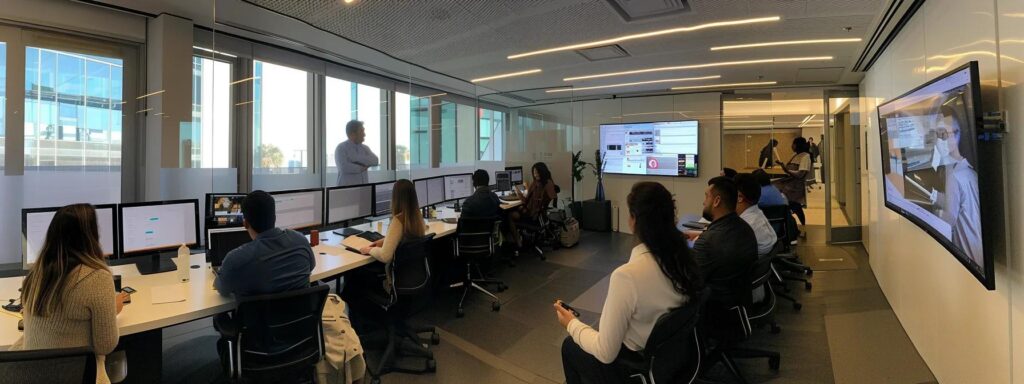Sustainable Urban Planning Strategies for Thriving Cities
Many urban areas face significant issues such as traffic congestion, pollution, and extreme weather impacts. Sustainable urban planning strategies offer effective solutions to these challenges by promoting environmental protection and innovative urban design. This blog post will explore key approaches, including integrating green infrastructure and enhancing transportation systems. By engaging with this content, readers will discover practical methods to create thriving cities that not only alleviate current urban problems but also foster long-term sustainability and resilience.
Understanding Sustainable Urban Planning Strategies

Defining key concepts and terminology is essential in understanding sustainable urban planning strategies, including the integration of smart grids and vehicle efficiency. Emphasizing sustainability ensures urban environments can support cycling initiatives and preserve wildlife. These insights stress the importance of holistic approaches to creating thriving, livable cities.
Defining Key Concepts and Terminology
Defining key concepts and terminology is fundamental to grasping sustainable urban planning strategies, focusing on terms such as sustainable development and social equity. These principles guide the creation of environmentally friendly urban spaces that prioritize natural resource management while minimizing risks such as flood impacts. By understanding these foundational concepts, city planners can foster initiatives that not only enhance community resilience but also promote equitable access to urban amenities.
Importance of Sustainability in Urban Environments
Sustainability in urban environments is critical for reducing consumption and air pollution, ensuring cities meet the needs of residents without depleting resources. Implementing effective policies can mitigate urban sprawl, encouraging dense, mixed-use development that promotes walkability. By enhancing walkability, cities can improve public health, decrease traffic emissions, and create vibrant communities where residents enjoy a higher quality of life.
Integrating Green Infrastructure in Urban Design

Green infrastructure plays a crucial role in sustainable urban design, offering benefits such as green roofs and walls that enhance climate resilience while reducing coal usage. Implementing urban forests and green spaces fosters community well-being and addresses affordable housing needs. Additionally, effective stormwater management solutions help lower the ecological footprint of cities, mitigating traffic-related issues and strengthening urban ecosystems.
Benefits of Green Roofs and Walls
Green roofs and walls significantly enhance urban environments by mitigating the effects of climate change and addressing the urban heat island phenomenon. By incorporating vegetation into architecture, these green infrastructure solutions provide natural insulation, reducing energy consumption and improving temperature regulation. Additionally, the soil used in these systems absorbs rainwater, contributing to effective stormwater management and promoting biodiversity in urban settings.
Implementing Urban Forests and Green Spaces
Implementing urban forests and green spaces is vital for enhancing ecological resilience within urban areas, especially in the context of globalization. These green initiatives can also serve as strategic sites for solar energy installations, aligning urban development with sustainable practices. Research shows that integrating greenery not only improves air quality but also provides social benefits, such as recreational spaces, thereby addressing community needs in densely populated environments.
Stormwater Management Solutions
Stormwater management solutions are essential in urban planning as they help reduce the carbon footprint of cities while promoting biodiversity. Techniques such as permeable paving allow rainwater to infiltrate the ground, minimizing runoff and enhancing groundwater recharge. Furthermore, effective zoning regulations can encourage the inclusion of green spaces and wetland restoration, addressing flooding concerns and supporting overall ecological health.
| Stormwater Management Solutions | Benefits | Examples |
|---|---|---|
| Permeable Paving | Reduces runoff, promotes infiltration | Parking lots, walkways |
| Rain Gardens | Enhances biodiversity, filters pollutants | Public parks, residential areas |
| Green Roofs | Improves insulation, captures rainwater | Commercial buildings, residential developments |
| Wetland Restoration | Supports wildlife, mitigates flooding | Natural parks, urban watersheds |
Promoting Mixed-Use Development

Mixed-use development enhances community interaction and connectivity by integrating residential, commercial, and recreational spaces. This approach reduces dependence on vehicles, which can lead to decreased construction waste and lower environmental impacts. Successful examples demonstrate the potential for biofuel utilization and the importance of knowledge sharing in design and implementation, while mitigating risks associated with urban sprawl.
Enhancing Community Interaction and Connectivity
Enhancing community interaction and connectivity through mixed-use development actively supports economic growth while countering environmental degradation in urban areas. In New York City, for instance, integrating residential, commercial, and recreational spaces fosters vibrant habitats where residents can easily access diverse amenities without relying heavily on transport. This design approach not only reduces travel distances but also creates a sense of community, encouraging social interactions and cohesive neighborhoods.
Reducing Dependence on Vehicles
Reducing dependence on vehicles is a key strategy in promoting mixed-use development, significantly contributing to sustainability and enhancing the quality of urban life. By integrating cycling infrastructure and pedestrian-friendly amenities, cities can create environments that encourage residents to choose active transportation modes. This shift not only leads to energy conservation but also positively impacts the cost of living by reducing transportation expenses.
- Promoting cycling infrastructure to enhance active transportation.
- Integrating residential, commercial, and recreational spaces to foster accessibility.
- Encouraging energy conservation through reduced reliance on vehicles.
- Addressing the cost of living by minimizing transportation expenses.
Examples of Successful Mixed-Use Projects
Successful mixed-use projects exemplify how urban resilience can be achieved while promoting sustainable practices. For instance, the Granville Island district in Vancouver integrates residential, commercial, and recreational spaces, reducing reliance on fossil fuel transportation and enhancing community engagement. Incorporating features such as green roofs, these developments support a circular economy by recycling resources and creating environments that foster both ecological health and social interaction.
Enhancing Public and Active Transportation Systems

Expanding public transit networks is vital for increasing access to essential services, thereby improving quality of life and addressing issues like poverty. Designing walkable and bike-friendly communities enhances stakeholder involvement and promotes healthier lifestyles. Case studies will illustrate effective transportation strategies, showcasing the role of analytics in enhancing water quality and overall urban sustainability.
Expanding Public Transit Networks
Expanding public transit networks is vital for improving accessibility in urban areas, which can significantly reduce social inequality. Enhanced transit options allow individuals from diverse backgrounds to access essential services and job opportunities, directly addressing environmental issues linked to vehicle emissions. By fostering efficient public transportation systems, cities contribute to climate change mitigation while supporting green building initiatives that promote sustainable practices in urban development.
Designing Walkable and Bike-Friendly Communities
Designing walkable and bike-friendly communities is essential for promoting sustainable transport systems that benefit current and future generations. Incorporating elements like dedicated bike lanes and pedestrian pathways can facilitate access to rapid transit options, ensuring that residents have efficient routes to essential services. Furthermore, thoughtfully integrating green infrastructure can improve the management of water resources while utilizing natural elements like wind for energy efficiency, contributing to a healthier urban ecosystem.
Case Studies of Effective Transportation Strategies
Case studies exemplifying effective transportation strategies showcase how urban planning strategies can significantly impact ecology and carbon reduction goals. Cities like Copenhagen have implemented extensive cycling infrastructure, which not only promotes active transportation but also creates a robust transportation network that strengthens society’s reliance on sustainable practices. By analyzing these successful models, urban planners can adopt efficient solutions that yield environmental benefits while enhancing community well-being.
- Integration of cycling infrastructure in Copenhagen.
- Active transportation promotes healthier, more engaged communities.
- Case studies provide actionable insights for urban planners.
- Strategies align environmental goals with societal needs.
Implementing Sustainable Building Practices

Utilizing energy-efficient technologies is essential in creating sustainable building practices that align with modern agricultural and urban infrastructure needs. Incorporating sustainable materials and acquiring green certifications and ratings not only promotes climate resilience but also enhances understanding of renewable energy solutions. Each of these aspects contributes to developing buildings that support thriving urban environments.
Utilizing Energy-Efficient Technologies
Utilizing energy-efficient technologies in building practices is essential for modern urbanism, particularly in reducing greenhouse gas emissions and minimizing pollution. By integrating smart building systems and renewable energy sources, developers can create structures that align with the natural environment while supporting sustainable urban landscapes. This approach not only decreases energy consumption but also enhances the overall well-being of urban residents:
| Energy-Efficient Technologies | Impact on Urbanism | Benefits |
|---|---|---|
| Smart Building Systems | Reduces operational energy use | Lower energy bills, enhanced comfort |
| Solar Panels | Utilizes renewable resources | Decreases reliance on fossil fuels |
| High-Performance Insulation | Improves energy retention | Minimizes heating and cooling demands |
| LED Lighting | Promotes energy efficiency | Reduces electricity consumption |
Incorporating Sustainable Materials
Incorporating sustainable materials into building practices is a fundamental aspect of smart growth, significantly enhancing urban environments. By utilizing recycled or locally sourced materials, developers not only reduce waste but also promote sustainable finance criteria that support healthier communities. This concept aligns with pedestrian-friendly designs, ensuring that the structures contribute positively to the social fabric of cities while minimizing their environmental impact.
Green Certifications and Ratings
Green certifications and ratings play a crucial role in promoting sustainable urban development by providing a framework for measuring the environmental impact of buildings. These certifications guide developers in optimizing land use, improving stormwater management practices, and contributing to reforestation efforts through sustainable design principles. By choosing certified sustainable building materials and practices, cities can address common challenges such as reducing energy consumption and enhancing community resilience, ultimately leading to thriving urban environments that benefit both residents and the ecosystem.
Fostering Community Engagement in Urban Planning

Encouraging local participation in planning processes is fundamental for developing a sustainable city. Educating residents about sustainability helps foster a culture of responsibility toward issues like water pollution. Building collaborations between stakeholders ensures a comprehensive evaluation of community needs, addressing the integration of renewable resources such as hydroelectricity for a resilient urban future.
Encouraging Local Participation in Planning Processes
Encouraging local participation in urban planning processes is fundamental for creating sustainable cities that address community needs effectively. By engaging residents and incorporating their insights on topics such as recycling and energy efficiency, urban planners can enhance disaster preparedness and integrate principles of landscape architecture. This collaborative approach not only fosters a sense of ownership among community members but also aligns with corporate social responsibility initiatives that prioritize environmental stewardship and resilience in urban development.
Educating Residents on Sustainability
Educating residents on sustainability is a vital aspect of fostering community engagement in urban planning. By promoting understanding of sustainable development goals and governance, communities can better recognize the role of public transport and the private sector in achieving these objectives. Practical workshops and local initiatives can empower citizens to embrace environmentalism, encouraging them to actively participate in shaping their urban environments through informed decisions and collaborative efforts.
Building Collaborations Between Stakeholders
Building collaborations between stakeholders is essential for fostering community engagement in urban planning efforts aimed at creating sustainable cities. In Curitiba, Brazil, effective partnerships between government, private sector, and local communities have demonstrated significant progress in addressing natural resource management and ensuring safety through innovative strategies. By utilizing tools such as the internet of things, stakeholders can efficiently monitor resources and combat resource depletion, ultimately leading to enhanced urban living conditions and a more resilient community.
- Establish partnerships among government, private sector, and local communities.
- Utilize innovative technologies like the internet of things to monitor urban resources.
- Address natural resource management and safety concerns effectively.
- Combat resource depletion to ensure sustainable development.
Conclusion
Sustainable urban planning strategies play a vital role in creating thriving cities that prioritize environmental resilience and community well-being. By integrating green infrastructure, promoting mixed-use development, and expanding public transportation, cities can foster vibrant, accessible environments that reduce reliance on vehicles. Engaging residents and stakeholders ensures that urban planning reflects community needs and values, further enhancing the effectiveness of these strategies. Prioritizing sustainability is essential for addressing current challenges and securing a healthier, more equitable urban future.




















































